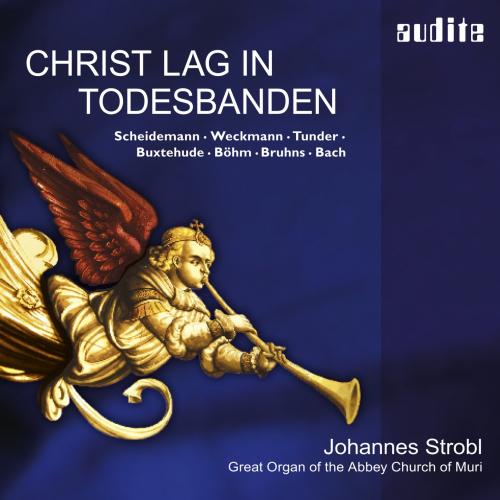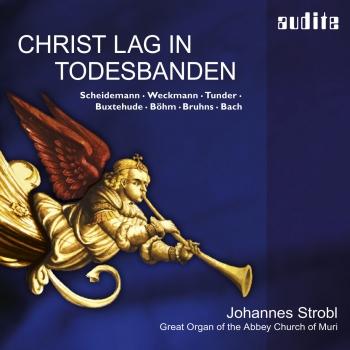
Christ lag in Todesbanden Johannes Strobl
Album info
Album-Release:
2008
HRA-Release:
14.04.2021
Label: audite Musikproduktion
Genre: Classical
Subgenre: Chamber Music
Artist: Johannes Strobl
Composer: Nicolaus Bruhns (1665-1697), Matthias Weckmann (1619-1674), Johann Sebastian Bach (1685-1750), Heinrich Scheidemann (1596-1663), Georg Böhm (1661-1733), Franz Tunder (1614-1667), Dieterich Buxtehude (1637-1707)
Album including Album cover
- Heinrich Scheidemann (1596 - 1663): Christ lag in Todesbanden:
- 1 Christ lag in Todesbanden: 1. Versus, Pedaliter 02:38
- 2 Christ lag in Todesbanden: 2. Versus auf 2 clavir. Pedaliter 02:47
- 3 Christ lag in Todesbanden: 3. Versus 01:57
- Matthias Weckmann (1619 - 1674):
- 4 Praeambulum primi toni a 5 03:39
- Franz Tunder (1614 - 1667):
- 5 Christ lag in Todesbanden 11:40
- Dietrich Buxtehude (1637 - 1707):
- 6 Praeludium in C, BUXWV 138 03:47
- Georg Böhm (1661 - 1733):
- 7 Christ lag in Todesbanden 04:11
- Nicolaus Bruhns (1665 - 1697):
- 8 Praeludium in G 07:54
- Johann Sebastian Bach (1685 - 1750):
- 9 Fantasia super "Christ lag in Todesbanden" - Choralis in alto, Manualiter, BWV 695 04:22
- Sontata in C, BWV 529:
- 10 Sontata in C, BWV 529: I. Allegro 05:21
- 11 Sontata in C, BWV 529: II. Largo 05:32
- 12 Sontata in C, BWV 529: III. Allegro 04:00
- Toccata et Fuga in F, BWV 540:
- 13 Toccata et Fuga in F, BWV 540: I. Toccata 08:39
- 14 Toccata et Fuga in F, BWV 540: II. Fuge 06:17
Info for Christ lag in Todesbanden
With the reconstruction of the historic bellows mecanism the restoration of the Great Organ in the Abbey Church at Muri was successfully completed in the autumn of 2005. The present album is the first documentary recording of the sound of the Great Organ after the completion of its restoration. The historic organs in the Abbey Church at Muri in the Swiss canton of Aargau are highly esteemed across the Swiss borders. Every year experts and enthusiasts from all over the world visit the historic organs in Muri.
The Great Organ was built by Thomas Schott in 1619-1630, enlarged in 1744 by Joseph and Viktor Ferdinand Bossard, and immaculately restored nearly 40 years ago.
The recorded works by North German baroque composers and by J.S. Bach have been carefully chosen in consideration of the qualities of the instrument. The homogeneous and original baroque sound of the organ ensures the adequate reproduction of the works.
Moreover the chosen music allows a comparison between compositional styles of the same period: Four baroque composers are presented with their chorale settings of “Christ lag in Todesbanden” (Herinrich Scheidemann, Franz Tunder, Georg Böhm, Johann Sebastian Bach). The choice of the Easter chorale “Christ lag in Todesbanden” creates a link with its place of origin, since the Muri Easter Play is held to be the earliest drama in the German language. The chorale settings are completed by three Preludes (Matthias Weckmann, Dietrich Buxtehude, Nicolaus Bruhns) and a Sonata and a Toccata by J.S. Bach.
The various possible approaches to setting a cantus firmus are illustrated in this recording, as are a range of examples of independent organ works in the North German tradition, whose influence may be traced in the art of Johann Sebastian Bach.
Johannes Strobl has performed as a soloist and ensemble musician in many European countries and in Israel, Japan, the USA, Brazil and Argentina. In 1998 he was a prizewinner at the Paul Hofhaimer Competition in Innsbruck, and in 2000 together with “Les Cornets Noirs” – an ensemble specialized in 17th-century music – at the “concours musica antiqua” in Bruges.
Johannes Strobl also appears with increasing frequency as conductor of Cappella Murensis, a professional vocal ensemble which found its home in the Abbey Church at Muri in 2002. He and his ensemble achieved outstanding success with the release of the rediscovered “Mass of Muri” by Johann Valentin Rathgeber (aud.92.559). Since 2001 Johannes Strobl has been organist at the Abbey Church at Muri . In addition to his ecclesiastical duties he is the artistic director of the concert series “Music in the Abbey Church at Muri”.
Johannes Strobl, organ
Johannes Strobl
stammt aus Kärnten/Österreich und absolvierte sein Musikstudium an der Hochschule für Musik und Darstellende Kunst "Mozarteum" in Salzburg, wo er in der Klasse von Heribert Metzger Lehr- und Konzertdiplom im Fach Orgel sowie das A-Diplom in Katholischer Kirchenmusik mit Auszeichnung ablegte. Parallel dazu inskribierte er an der Paris-Lodron-Universität Salzburg die Fächer Musikwissenschaft und Romanistik. Es folgte ein umfassendes Studium der Alten Musik an der Schola Cantorum Basiliensis bei Jean-Claude Zehnder (Orgel), Jörg-Andreas Bötticher (Cembalo), Jesper Christensen (Generalbass) und Rudolf Lutz (Improvisation). Kurse bei Michael Radulescu, Luigi Ferdinando Tagliavini, Harald Vogel, Almut Rössler und James David Christie ergänzten seine Ausbildung.
Im Jahr 1998 war Johannes Strobl Preisträger beim Paul-Hofhaimer-Wettbewerb in Innsbruck, im Jahr 2000 beim concours musica antiqua in Brügge mit dem auf die Musik des Frühbarock spezialisierten Ensemble Les Cornets Noirs.
Johannes Strobl konzertierte als Solist und Ensemblemusiker in vielen europäischen Ländern, in Israel, Japan, den USA, Brasilien und Argentinien. Engagements renommierter Alte-Musik-Ensembles (Concerto Vocale, Concerto Köln, Capriccio Barockorchester, La Fontaine, Turicum, Die Freitagsakademie, La Cetra) wie moderner Orchester (Camerata Salzburg, Sinfonieorchester Basel, SWR Sinfonieorchester, Wiener Philharmoniker) zur Mitwirkung an Konzerten und Tourneen, Rundfunk-, Fernseh- und CD-Produktionen führten zu Begegnungen mit Dirigenten wie Sir Roger Norrington, René Jacobs, Attilio Cremonesi, Michael Gielen, Peter Schreier, Frieder Bernius, Ivor Bolton, Howard Griffiths, Stephan Soltesz, Vladimir Ashkenazy, Michel Corboz und Hans-Michael Beuerle.
2001 wurde Johannes Strobl zum hauptverantwortlichen Kirchenmusiker der Pfarrei St. Goar in Muri AG gewählt und betreut in dieser Funktion die bedeutende historische Orgelanlage der Klosterkirche Muri. Als künstlerischer Leiter der Konzertreihe Musik in der Klosterkirche Muri belebt er die aargauische Kulturlandschaft mit aussergewöhnlichen Projekten wie Aufführungen mehrchöriger Musik von den vier Emporen des oktogonalen Raumes oder historisch informiert in Szene gesetzten Karwochenoratorien vom Wiener Habsburger Hof.
Mit dem an der Klosterkirche Muri beheimateten professionellen Vokalensemble Cappella Murensis tritt Johannes Strobl auch als Dirigent in Erscheinung. Neben den Kirchenwerken von Monteverdi, Bach, Händel und Mozart steht immer auch weniger Bekanntes aus dem Repertoire des 17. und 18. Jahrhunderts auf den Programmen, darunter nicht selten Erstaufführungen unbekannter Musik aus Schweizer Klöstern, dokumentiert in Mitschnitten von SRF 2 und Espace 2 sowie in der Ersteinspielung von Johann Valentin Rathgebers "Messe von Muri", erschienen 2007 bei audite.
2008 trat Johannes Strobl mit einer ersten Solo-SACD an die Öffentlichkeit: "Christ lag in Todesbanden", aufgenommen an der Grossen Orgel der Klosterkirche Muri, vereint Literatur der norddeutschen Orgelschule und Werke von Johann Sebastian Bach und erhielt den Vierteljahrespreis der Deutschen Schallplattenkritik. Für "Polychoral Splendour", mehrchörige Musik von Giovanni Gabrieli und Heinrich Schütz, aufgenommen von den vier Emporen der Klosterkirche Muri (audite 2012), wurden die Cappella Murensis und das Ensemble Les Cornets Noirs unter seiner Leitung mit dem International Classical Music Award 2013 in der Sparte Baroque vocal ausgezeichnet.
This album contains no booklet.












